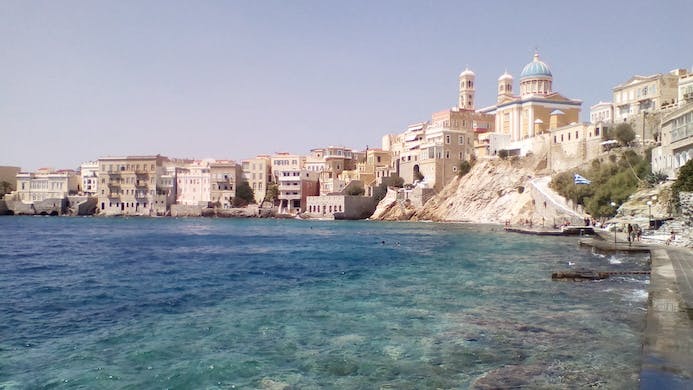Why Our Ambassador’s ‘Worry’ About This Greek Island Is Misplaced
Syros has none of the kind of tourist infrastructure you’ll find a few miles across the Aegean, in Mykonos.

The small Greek island of Syros is now “very much on the tourist map,” the American ambassador to Greece said with “worry” during an interview with a Greek newspaper recently. Geoffrey Pyatt needn’t fret, though, because Syros has always been impervious to tourism, an island whose character not even the Instagram brigades could dilute.
For one thing, there’s none of the kind of tourist infrastructure you’ll find a few miles across the Aegean, in Mykonos. One has to look hard to find a trendy boutique hotel, though new spots like the Hotel Aristide, a design-driven bolthole in a refurbished neoclassical building facing the sea, do spell intrigue.
The second time I saw the quixotic city of Ermoupoli, the regional capital of Greece’s Cycladic islands and the main town on Syros, I was convinced I had been cast ashore onto some kinder, cleaner iteration of Piraeus, the teeming Athenian port. The gracious pastel-shaded facades are gentler than that classic cubist white, and even the industrial tangle of the famed Neorion shipyards, now American-owned, can seem more like a semi-amphibious art installation than a working harbor.
If you like swimming but hate sand, this is your island: All one has to do to find the sea is cross over the wide expanse of Miaoulis Square and slink like a seahorse through the lanes of Vaporia, with their neoclassical sea captains’ mansions and ornate balconies. There are some secret places to jump in and also some quite social ones, like the almost roisterous seafront Asteria Beach Bar. There, you can be sipping your Greek coffee one moment and swimming the next.
Once, having turned away from the surreal sight of the big blue dome of Agios Nikolaos looming over the water line, I jumped into the sea next to the artsy Ploes Hotel. I swam over to the edge of what I assumed to be just another pleasant seafront bar and climbed up a small ladder extending into the water. The place had a beautiful terrace straight out of a James Bond film, but I couldn’t find anyone to take my order and so just idled there for a moment, dripping wet. Finally, an elegant lady in a black bathing suit and sunglasses turned up.
“Hi!” I chirped. “Can I see a drinks menu?”
The lady lowered her sunglasses, looked at me as if I had just escaped from the nearest lunatic asylum, and said dryly, “This is our house.”
The first time I saw Syros, it was with a certain apprehension. Approaching from the sea, two rather severe hilltops come into view, each with antique houses piled on high amphitheatrically and somewhat defiantly, as if issuing a silent dare to any tsunami that might arise from a Santorini eruption.
Ermoupoli looks nothing like the chief towns you’ll find on islands elsewhere in these parts because it was all constructed in the 1820s, during the Greek War of Independence. It was a boomtown, attracting Greek refugees from other islands who arrived ready to roll up their sleeves and work: It would be a long while, in fact, before Piraeus eclipsed its commercial heft. Way before that, from 1204 to the day in 1522 when the Ottoman corsair Barbarossa sailed in, the empire of Venice held sway.
So it is that one of those two hills you see soaring over the port is the older Ano Syros, largely medieval-Venetian in aspect and crowned with the 13th century Catholic cathedral of St. George. The hilltop that is not Ano Syros is graced with a Greek Orthodox church.
Poke around and you might find the tiny archeology museum, tucked into one wing of the grandiose 1876 Town Hall that was built by Ernst Ziller, the German-born architect who made his mark in Greek cities like Athens, Patras, and this one. The Apollon Theater is the island’s opera house — to my knowledge the only one on any Greek island. The Luftwaffe bombed the one in Corfu in 1943. There are restaurants and shops galore, none of which are touristy.
New Yorkers of a certain age will remember Manganaro’s Italian grocery on Ninth Avenue; find the fragrant Syrosian equivalent in the Prekas delicatessen, which is jam-packed with Mediterranean herbs and spices, wheels of artisanal Syros cheeses, a local fig liqueur packaged in pretty bottles that sell out fast, a culinary wonder called caper jam that pairs nicely with those cheeses and that you’ll find nowhere else, and lots more.
Ermoupoli’s sinuous Protopapadaki Street unfolds in a long, elegant curve behind the busy seafront. Unless I am mistaken, it is paved not with asphalt but with marble. It’s gorgeous.
Passing by before my three-hour ferry ride back to Piraeus, I caught sight of a shutterbug setting up for a photo shoot, and why shouldn’t he be? The street is a Cycladic island red carpet of sorts, and Syros — as our man in Greece correctly senses — is ready for its close-up.

